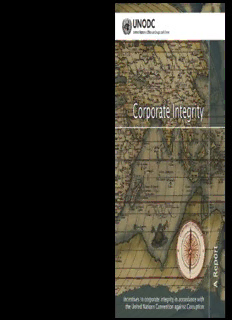
Incentives for corporate integrity in accordance with the United Nations Convention against ... PDF
Preview Incentives for corporate integrity in accordance with the United Nations Convention against ...
(cid:82)(cid:101)(cid:103)(cid:105)(cid:111)(cid:110)(cid:97)(cid:108)(cid:32)(cid:79)(cid:102)(cid:102)(cid:105)(cid:99)(cid:101)(cid:32)(cid:102)(cid:111)(cid:114)(cid:32)(cid:83)(cid:111)(cid:117)(cid:116)(cid:104)(cid:32)(cid:65)(cid:115)(cid:105)(cid:97)(cid:44) (cid:69)(cid:80)(cid:32)(cid:49)(cid:54)(cid:47)(cid:49)(cid:55)(cid:44)(cid:32)(cid:67)(cid:104)(cid:97)(cid:110)(cid:100)(cid:114)(cid:97)(cid:103)(cid:117)(cid:112)(cid:116)(cid:97)(cid:32)(cid:77)(cid:97)(cid:114)(cid:103)(cid:44) (cid:67)(cid:104)(cid:97)(cid:110)(cid:97)(cid:107)(cid:121)(cid:97)(cid:112)(cid:117)(cid:114)(cid:105)(cid:44)(cid:32)(cid:78)(cid:101)(cid:119)(cid:32)(cid:68)(cid:101)(cid:108)(cid:104)(cid:105)(cid:45)(cid:49)(cid:49)(cid:48)(cid:48)(cid:50)(cid:49)(cid:44)(cid:32)(cid:73)(cid:110)(cid:100)(cid:105)(cid:97) (cid:73)(cid:110)(cid:99)(cid:101)(cid:110)(cid:116)(cid:105)(cid:118)(cid:101)(cid:115)(cid:32)(cid:116)(cid:111)(cid:32)(cid:99)(cid:111)(cid:114)(cid:112)(cid:111)(cid:114)(cid:97)(cid:116)(cid:101)(cid:32)(cid:105)(cid:110)(cid:116)(cid:101)(cid:103)(cid:114)(cid:105)(cid:116)(cid:121)(cid:32)(cid:105)(cid:110)(cid:32)(cid:97)(cid:99)(cid:99)(cid:111)(cid:114)(cid:100)(cid:97)(cid:110)(cid:99)(cid:101)(cid:32)(cid:119)(cid:105)(cid:116)(cid:104)(cid:32) (cid:80)(cid:114)(cid:105)(cid:110)(cid:116)(cid:101)(cid:100)(cid:58)(cid:32)(cid:78)(cid:101)(cid:119)(cid:32)(cid:68)(cid:101)(cid:108)(cid:104)(cid:105)(cid:44)(cid:32)(cid:50)(cid:48)(cid:49)(cid:51)(cid:32)(cid:64)(cid:32)(cid:51)(cid:48)(cid:48)(cid:32)(cid:99)(cid:111)(cid:112)(cid:105)(cid:101)(cid:115) (cid:116)(cid:104)(cid:101)(cid:32)(cid:85)(cid:110)(cid:105)(cid:116)(cid:101)(cid:100)(cid:32)(cid:78)(cid:97)(cid:116)(cid:105)(cid:111)(cid:110)(cid:115)(cid:32)(cid:67)(cid:111)(cid:110)(cid:118)(cid:101)(cid:110)(cid:116)(cid:105)(cid:111)(cid:110)(cid:32)(cid:97)(cid:103)(cid:97)(cid:105)(cid:110)(cid:115)(cid:116)(cid:32)(cid:67)(cid:111)(cid:114)(cid:114)(cid:117)(cid:112)(cid:116)(cid:105)(cid:111)(cid:110) INDIA: Incentives for corporate integrity in accordance with the United Nations Convention against Corruption Disclaimer: “The designations employed and the presentation of material in this publication do not imply the expression of any opinion whatsoever on the part of UNODC concerning the legal status of any country, territory or city or its authorities, or concerning the delimitation of its frontiers or boundaries.” Disclaimer for the cover: “The boundaries and names shown and the designations used on this map do not imply official endorsement or acceptance by the United Nations. Dashed lines represent undetermined boundaries.” A report on: Compliance of Indian laws and policies on private sector corruption with the United Nations Convention against Corruption (UNCAC). And Current practices, grassroot challenges and training needs required to be addressed to strengthen corporate integrity and compliance with the United Nations Convention against Corruption. This report can also be viewed at: http://www.unodc.org/southasia/en/menu/publications. html INDIA: Incentives for corporate integrity in accordance with the United Nations Convention against Corruption iii TTaabbllee ooff CCoonntteennttss Acknowledgements ......................................................................................................... vii Definitions .......................................................................................................................ix Acronyms ........................................................................................................................xi 1. Executive Summary ......................................................................................................1 2. Approach and Methodology .........................................................................................5 3. United Nations Convention against Corruption (UNCAC) ..............................................9 4. Introduction: Private sector and corruption ................................................................15 5. National legislation on private sector corruption ........................................................17 5.1 Analysis: Compliance of Indian legislation with UNCAC ......................................17 5.1.1 Article 12: Private sector ..........................................................................17 5.1.2 Article 21: Bribery in the private sector ....................................................26 5.1.3 Article 26: Liability of legal persons .........................................................30 5.1.4 Article 32: Protection of witnesses, experts and victims ...........................32 5.1.5 Article 33: Protection of reporting persons ..............................................35 5.1.6 Article 37: Cooperation with law enforcement authorities ........................37 5.1.7 Article 39: Cooperation between national authorities and the private sector. .........................................................................................40 Table 1: Summary of Indian legislation and policy compliance with the UNCAC ...........................................................................................41 INDIA: Incentives for corporate integrity in accordance with the United Nations Convention against Corruption v 6. Grassroot challenges, current practices and training needs .......................................49 7. Recommendations ....................................................................................................83 Annexures Annexure 1: List of legislation and policy reviewed ....................................................91 Annexure 2 : Sampling strategy followed for survey ...................................................93 Annexure 3 : Survey questionnaire - Private sector .....................................................94 Annexure 4 : Survey questionnaire - Law enforcement .............................................104 Annexure 5 : List of Working Group participants - New Delhi & Bangalore ................112 Annexure 6 : Bibliography .......................................................................................117 vi INDIA: Incentives for corporate integrity in accordance with the United Nations Convention against Corruption AAcckknnoowwlleeddggeemmeenntt Concept and Technical Oversight: UUNNOODDCC,, RReeggiioonnaall OOffffiiccee ffoorr SSoouutthh AAssiiaa Ms. Cristina Albertin, Representative Ms. Suruchi Pant, Deputy Representative Mr. Rajendra Sharma, Anti-corruption and Crime Prevention Expert Ms. Neiha Bansal, Project Officer, Anti-Corruption and Crime Prevention UNODC, HQ, Vienna, Corruption and Economic Crime Branch Ms. Shannon Bullock, Programme Officer, Legal Incentives and Public Procurement Legislative and Policy Assessment: Centre for Policy Research (CPR) Mr. T R Raghunandan, Advisor, Accountability India Initiative Mr. Swaroop Iyengar, Consultant- Accountability India Initiative Ms. Uthara Narayanan, Consultant and Research Associate Ms. Suhasini Rao Kashyap, Consultant and Research Associate Survey on Practice and Training Needs Assessment: Ernst and Young Pvt. Limited Mr. Vineet Mehta, Associate Director Mr. Saurabh Gupta, Manager Mr. Arpinder Singh, Partner & National Director Mr. Vivek Aggarwal, Partner SSppeecciiaall aacckknnoowwlleeddggeemmeennttss:: UNODC would like to thank all the participants of the two ‘Expert Working Group’ who gave their time and their valuable inputs during the discussions held at the meetings and afterwards too. UNODC would like to acknowledge the support received from the Ministry of Personnel, Public Grievances and Pensions, Department of Personnel and Training, Government of India to conduct the survey and develop this report. INDIA: Incentives for corporate integrity in accordance with the United Nations Convention against Corruption vii
Description: